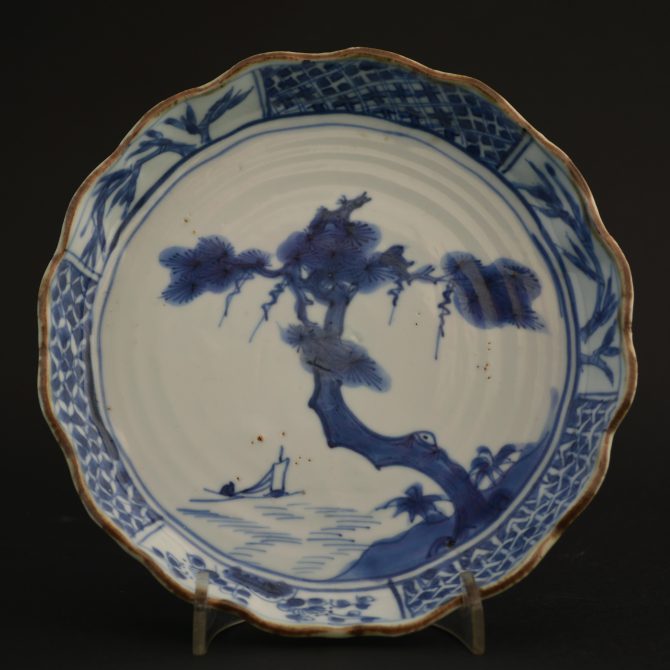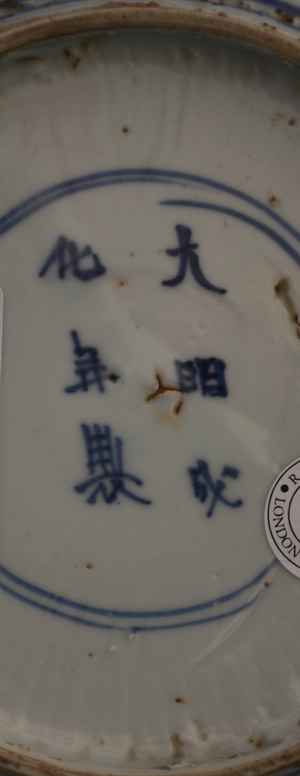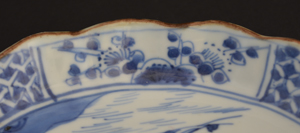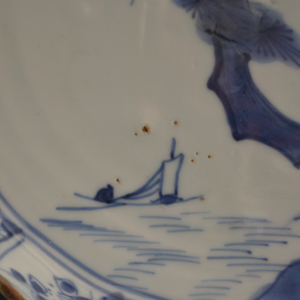
TIANQI or CHONGZHEN 1621 – 1644 Ming Porcelain
A Ming Blue and White Porcelain Kaiseki (Serving dish) for the Japanese Market. Late Ming Dynasty, Tianqi or Chongzhen c.1620-1640. The Thickly Potted Dish Depicts an Old Pine Tree with a Creeper Growing from its Bough. A Small Solitary Vessel is Behind the Tree. The Border is of Diaper Design with Three Panels, Two of Bamboo and One of Prunus. The Base with a Carelessly Drawn Apocryphal Chenghua Mark. The Rim with an Iron-Oxide Kuchibeni (Meaning lipstick).
SOLD
- Condition
- In excellent condition, one minute frit c.2 x1 mm.
- Size
- Diameter : 15 cm (6 inches)
- Provenance
- From a Private English Collection of Chinese and Japanese Blue and White Porcelain.
- Stock number
- 24111
Information
Ko-Sometsuke :
Ko-Sometsuke, meaning `Old Blue and White` is a term used to describe Chinese blue and white porcelain made for Japan. This late Ming porcelain was made from the Wanli period (1573-1620) and ended in the Chongzhen period (1628-1644), the main period of production being the 1620`2 and 1630`s. The porcelain objects produced were made especially for the Japanese market, both the shapes and the designs were tailored to Japanese taste, the production process too allowed for Japanese aesthetics to be included in the finished object. Its seams firing faults were added, repaired tears in the leather-hard body were too frequent to not, in some cases, be deliberate. These imperfections as well as the fritting Mushikui (insect-nibbled) rims and kiln grit on the footrims all added to the Japanese aesthetic. The shapes created were often expressly made for the Japanese tea ceremony meal, the Kaiseki, small dishes for serving food at the tea ceremony are the most commonly encountered form. Designs, presumably taken from Japanese drawings sent to China, are very varied, often using large amount of the white porcelain contrasting well with the asymmetry of the design.
Apocryphal Marks :
Apocryphal marks are frequently encountered on Chinese porcelain, particularly on Kangxi Blue and White Porcelain but also on Transitional porcelain like the present example. The mark of the Ming Emperor Chenghua who reigned from 1465 to 1487 being by far the most common, other Ming marks include Jiajing (1522-1566) and less frequently Wanli (1573-1620). These marks were not added to the piece to deceive, but more as a sign of reverence to earlier potters of the Ming dynasty (1368-1644). Occasionally they are used on pieces copying Ming Porcelain, these objects were probably made for collectors who could not afford the Ming original. Tianqi is an early period for such an apocryphal mark.


